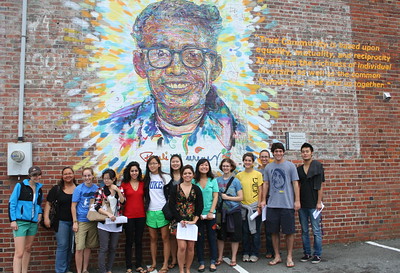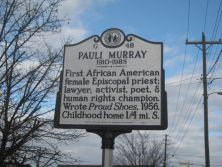Murray, Pauli
Individual perseverance and community power
By Sarajanee Davis and Kelly Agan, N.C.Government & Heritage Library, 2020; Revised by SLNC Government and Heritage Library, September 2024
From the NCpedia K-8 Collection
November 20, 1910- July 1, 1985
“What is often called exceptional ability is nothing more than persistent endeavor.” -- Pauli Murray

Can you think of a time when you had to try many times to achieve something you wanted?
If so, you may share something in common with activist, lawyer, poet and writer Pauli Murray. Dr. Murray was born in Baltimore, Maryland in 1910 as Anna Pauline Murray. Pauli moved to Durham at age three. Pauli's mother had died, and Pauli was sent to live with aunts in the area. In high school, Pauli participated in student government and played basketball. In 1925, Pauli graduated from Durham’s Hillside High School with honors. Hillside was one of Durham's all-black segregated schools during the time of segregation.
Pauli Murray wasn't stopped by injustice
Some people mistreated Dr. Murray due to Pauli's gender, race, and economic background. But Pauli refused to give up. After high school, Pauli hoped to attend Columbia University in New York City. The school used Pauli's gender to deny admission. So Pauli took extra classes and enrolled at nearby Hunter College. A few years later, Pauli wanted to move closer to home, and applied to the University of North Carolina Graduate School. This school used Pauli's race (African American) to deny admission.
 Pauli asked the N.A.A.C.P. (National Association for the Advancement of Colored People) to launch a lawsuit against the state, but the group did not take on Pauli's case. Thurgood Marshall encouraged Pauli to apply to Howard University’s law school. Once there, Pauli was the only woman in the program. Pauli stunned classmates and many on the faculty by once again graduating at the top of the class. Pauli was dedicated to fighting racial and gender discrimination. Dr. Murray is also known for starting important conversations about gender identity.
Pauli asked the N.A.A.C.P. (National Association for the Advancement of Colored People) to launch a lawsuit against the state, but the group did not take on Pauli's case. Thurgood Marshall encouraged Pauli to apply to Howard University’s law school. Once there, Pauli was the only woman in the program. Pauli stunned classmates and many on the faculty by once again graduating at the top of the class. Pauli was dedicated to fighting racial and gender discrimination. Dr. Murray is also known for starting important conversations about gender identity.
Dr. Murray's important contributions to human rights
Dr. Murray's ideas and writing were used by other lawyers to help end legal discrimination. Pauli wrote an important book called States' Laws on Race and Color. It studied segregation laws across the country. Supreme Court Justice Thurgood Marshall called it "the bible of the civil rights movement." And two Supreme Court justices used Murray's ideas to help fight discrimination when they were lawyers. Can you guess who they were? Thurgood Marshall and Ruth Bader Ginsberg. Pauli Murray also helped create the National Organization for Women in 1966.
Pauli Murray went on to be a college professor of law and African American and women's studies. And in 1961, President John F. Kennedy appointed Pauli to the Presidential Commission on the Status of Women. Pauli's longtime partner Irene Barlowe died in 1973. After Irene's death, Pauli found comfort in an already strong Christian faith. Pauli stopped working as a professor and enrolled in seminary school to become a priest. In 1977, Pauli became the first Black woman ordained as an Episcopal priest.
Dr. Murray’s life shows us how individual perseverance can lead to much bigger social change. Pauli Murray worked persistently to fight for and achieve fairness. But for a long time many people did not know who Pauli was, or Pauli's importance to the movements for social, racial and gender rights in the 20th century. In 2010, the State of North Carolina honored Pauli's childhood home in Durham by placing an historical marker. Pauli's childhood home in Durham has also been designated as a National Treasure and a National Historic Landmark. The home now serves as The Pauli Murray Center for History and Social Justice and is open to the public.
Pauli's memory has also been honored in other ways. In 2024, the U.S. Mint released the Reverend Dr. Pauli Murray quarter as part of the American Women Quarters Program. The quarter features Dr. Murray's face and the word "Hope." The quarter also reads, "a song in a weary throat," which was how Dr. Murray defined hope in the poem, "Dark Testament."
What can you and your peers do to make sure you treat people in your class, school, and community as equals?
References:
Cardillo, Julian. "Pauli Murray, Civil Rights icon and former professor, to appear on American Quarter." Brandeis University. https://www.brandeis.edu/75/stories/pauli-murray-quarter.html (accessed September 16, 2024).
Gilmore, Glenda. Defying Dixie: The Radical Roots of Civil Rights, 1919-1950 (New York: W.W. Norton & Company, 2008.
Hine, Darlene Clark, ed. Black Women in America: An Historical Encyclopedia (Oxford: Oxford University Press, 2005). P. 405-407
“Pauli Murray 1910-1985.” North Carolina Highway Historical Marker Program. https://ncmarkers.com/Markers.aspx?MarkerId=G-48 (accessed December 10, 2019).
Schulz, Kathryn. “The Many Lives of Pauli Murray.” The New Yorker. April 10, 2017. https://www.newyorker.com/magazine/2017/04/17/the-many-lives-of-pauli-murray (accessed December 10, 2019).
Additional Resources:
Cooper, Brittney. “Black, queer, feminist, erased from history: Meet the most important legal scholar you’ve likely never heard of.” Salon. February 18, 2015. https://www.salon.com/2015/02/18/black_queer_feminist_erased_from_histor... (accessed December 10, 2019).
Pauli Murray Project. Duke Human Rights Center at the Franklin Humanities Institute. https://www.paulimurraycenter.com/ (accessed December 10, 2019).
Wegner, Ansley. “Murray, Anna Pauline (Pauli).” NCpedia. Government & Heritage Library, 2010. https://www.ncpedia.org/murray-anna-pauline-pauli
Image Credits:
Kirk, Robin. "Human Rights Activism Class." Photograph. [Fall 2009). Flickr. Creative Commons CC BY 2.0. https://www.flickr.com/photos/rightsatduke/4172757560 (accessed January 21, 2020).
“Pauli Murray 1910-1985.” Photograph. North Carolina Highway Historical Marker Program. 2010. http://www.ncmarkers.com/Markers.aspx?MarkerId=G-48 (accessed December 10, 2019).
9 January 2020 | Agan, Kelly; Davis, Sarajanee